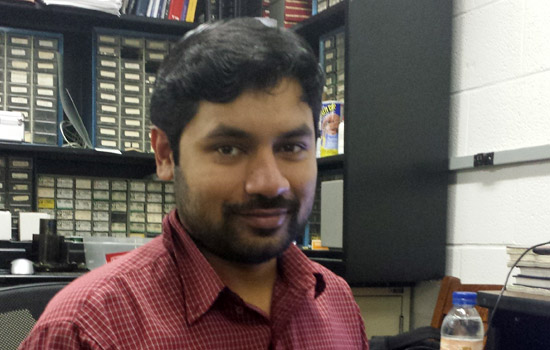Imaging science student wins ‘best paper’
Graduate student Saugata Sinha won Best Student Paper at the 2013 IEEE Western New York Image Processing Workshop for his work on detecting thyroid cancer.
A novel technique for detecting thyroid cancer was the topic of the Best Student Paper award at the 2013 IEEE Western New York Image Processing Workshop held on Nov. 22 at Rochester Institute of Technology.
Graduate student Saugata Sinha, a Ph.D. student in RIT’s Chester F. Carlson Center for Imaging Science, won the award based on reviewers’ recommendations and the presentation of his paper, “Differentiation between malignant and normal human thyroid tissue using frequency analysis of multispectral photoacoustic images.”
Conference organizer Nathan Cahill, associate professor in RIT’s School of Mathematical Science, described Sinha’s research and presentation as “great examples of the high quality we strive to achieve in this workshop.”
Photoacoustic imaging is a hybrid imaging technology in which laser light is absorbed by soft tissue to generate ultrasound waves. The nascent technique may emerge as a new method for screening thyroid and prostate cancers.
Sinha, originally from Kolkata, India, expects to earn his Ph.D. in summer 2014. His award-winning paper represents one aspect of his thesis research, which he conducts under Navalgund Rao, professor in the Center for Imaging Science, and Dr. Vikram Dogra, professor of radiology and urology in the department of imaging sciences at the University of Rochester Medical Center.
“Our preliminary results have shown that it is possible to differentiate between malignant and normal thyroid tissue using the frequency analysis technique of photoacoustic images taken at multiple light wavelengths,” Sinha said.
Previously, the team analyzed two-dimensional photoacoustic images based on intensity values in order to compare hemoglobin concentration in cancerous tissue with normal tissue.
“In this research, I have gone one step further and investigated the frequency content of the raw photoacoustic data, which can be related to shape, size and distribution of different light absorbing tissue constituents,” Sinha said. “The additional features provided by the frequency analysis technique can be combined with the features already extracted using intensity value based analysis and this combined set of features can be used for noninvasive characterization of tissue abnormality, which is our ultimate aim.”












